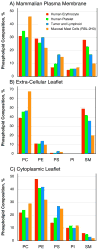Domain coupling in asymmetric lipid bilayers
- PMID: 18848518
- PMCID: PMC3099438
- DOI: 10.1016/j.bbamem.2008.09.003
Domain coupling in asymmetric lipid bilayers
Abstract
Biological membranes are heterogeneous assemblies of lipids, proteins, and cholesterol that are organized as asymmetric bimolecular leaflets of lipids with embedded proteins. Modulated by the concentration of cholesterol lipids and proteins may segregate into two or more liquid phases with different physical properties that can coexist in the same membrane. In this review, we summarize recent advances on how this situation can be recreated in a supported bilayer format and how this system has been used to demonstrate the induction of ordered lipid domains in lipid compositions that are typical for the inner leaflet by lipid compositions that are typical for the outer leaflet of mammalian plasma membranes. Proteins are shown to differentially target such induced inner leaflet domains.
Figures





References
-
- Singer SJ, Nicolson GL. The fluid mosaic model of the structure of cell membranes. Science. 1972;175:720–731. - PubMed
-
- Engelman DM. Membranes are more mosaic than fluid. Nature. 2005;438:578–580. - PubMed
-
- Daleke DL. Regulation of transbilayer plasma membrane phospholipid asymmetry. J Lipid Res. 2003;44:233–242. - PubMed
-
- Ferguson-Miller S, Hochman J, Schindler M. Aggregation and diffusion in the mitochondrial electron-transfer chain: role in electron flow and energy transfer. Biochem Soc Trans. 1986;14:822–824. - PubMed
-
- McConnell HM, Vrljic M. Liquid-liquid immiscibility in membranes. Annu Rev Biophys Biomol Struct. 2003;32:469–492. - PubMed
Publication types
MeSH terms
Substances
Grants and funding
LinkOut - more resources
Full Text Sources

